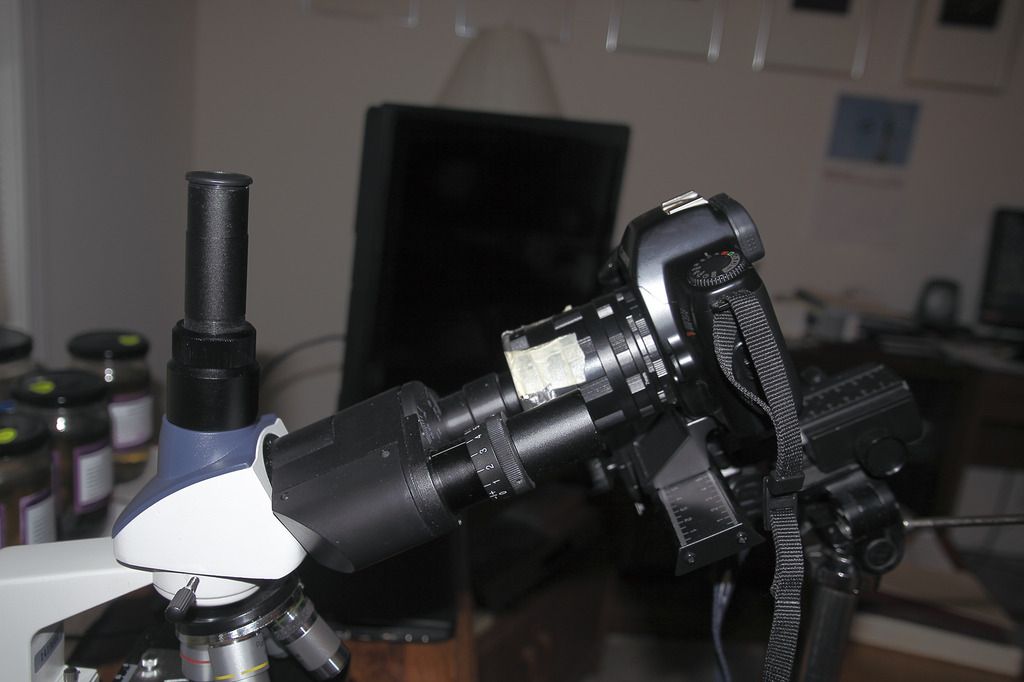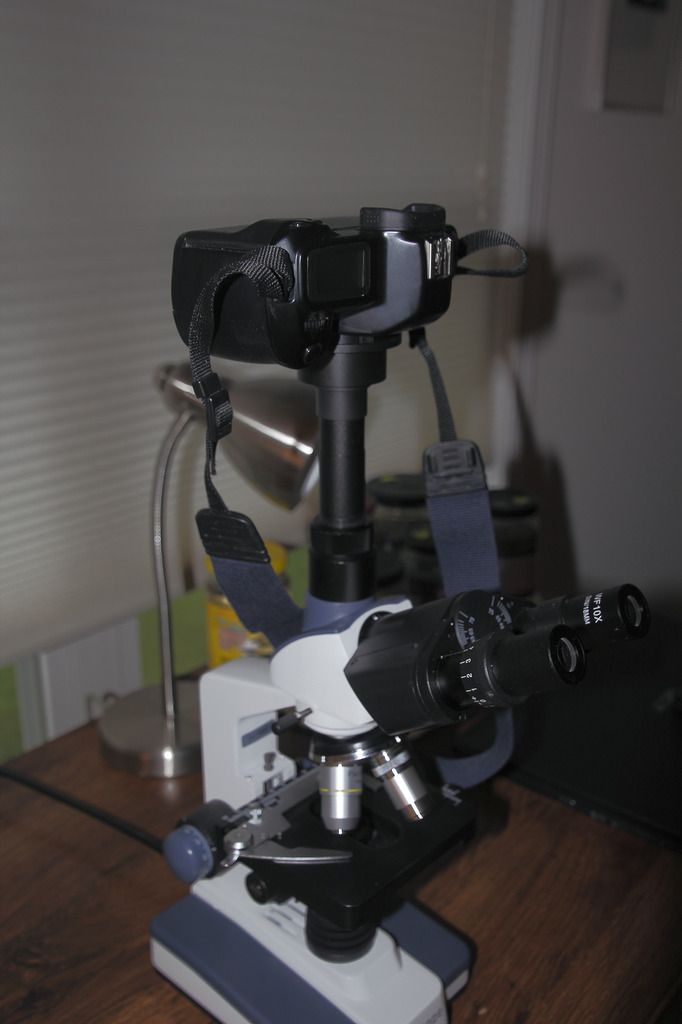I'll try to describe the way I connect my camera to the microscope, and also add some information that I learned along the way. I hope that I have not made too many errors, misstatements, or omissions, and if you notice any, please do point them out for the benefit of all.
There are two commonly used methods (A and B, described below) to connect a camera to a "compound" microscope.
A. Projection method: using a projection lens in the microscope and a camera body (a DSLR or a "mirrorless" camera with no camera lens attached).
1. I use an Olympus mirrorless camera body on a Nikon microscope fitted with a CF CL projection lens. The microscope is fitted with CF optics, where the correction for chromatic aberration is all taken care of in the objectives, such that compensating eyepieces are not (should not be) used. As far as I know, all (most?) other microscopes of the era (1970's and 1980's) with finite tubelength) require compensating eyepieces. I don't know enough about the modern Chinese finite tube length microscopes, nor about infinite tubelength microscopes, although my impression is that in the infinity systems, the tube-lens takes care of the necessary aberration correction.
Please correct or add more definitive information if you can. Olympus projection lenses for 160-mm tubelength are designated FK and NFK (for details see
http://www.alanwood.net/photography/oly ... ieces.html). Nikon projection lenses are desginated CF PL. The old 170-mm tubelength Leitz have "microprojection lenses" for objectives of low power, and "PERIPLAN microprojection lenses" for high power. I don't know about Zeiss or other brands.
2. It follows from the above that the projection lens (sometimes referred to as photo lens or relay lens, although I'm not sure about the exact meaning of those terms) for use with Nikon CF objectives must not incorporate correction for chromatic aberration, whereas those used with other finite tubelength microscopes must have correction that the objectives call for, hence they should be, ideally, made specifically for use with those objectives. Alternatively, a low power matching eyepiece of the same brand as the objectives can be used as a projection lens by raising it about 3-5 mm in the eye- or photo-tube.
3. Images of my setup:

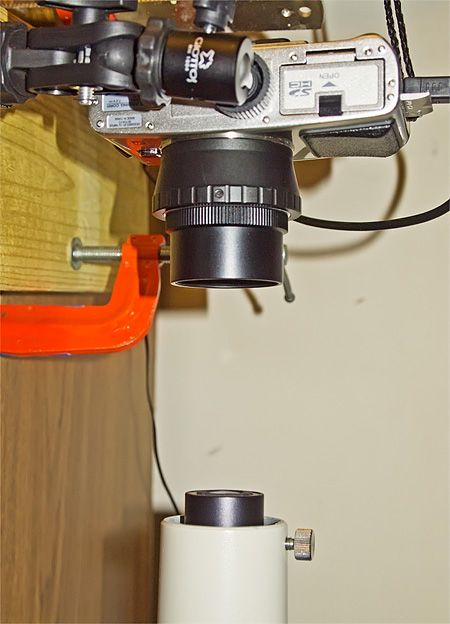
Left: The Olympus E-P1 micro four thirds camera and Nikon microscope assembly showing improvised camera "adapter".
Right: Camera fitted with the top half of the adapter, consisting of a camera-to-M42 screw-mount lens adapter and one section of an M42 extension tube. The picture also shows the projection lens in the phototube of the microscope's trinocular head.
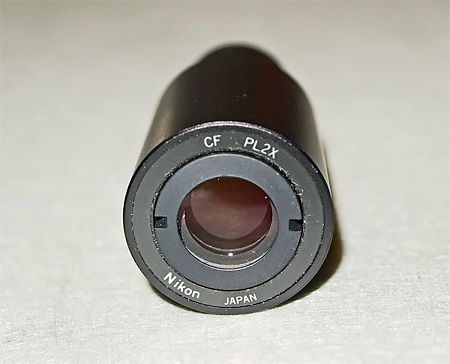
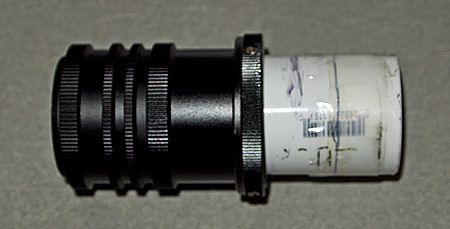
Left: Nikon CF PL 2x projection lens
Right: Set of M42 extension tubes and PVC plumbing tube attached with glue, forming the bottom half of the adapter. The inside of the PVC tube is painted matte black.


Left: The complete camera "adapter" in place, showing the gap that prevents transmission of the shutter vibration to the microscope.
Right: The gap between the top and bottom parts of the adapter is covered loosely with cloth to help prevent dust from getting on the projection lens and camera sensor. To prevent light from leaking onto the sensor, the cloth is then wrapped with opaque black paper as shown in the first picture.
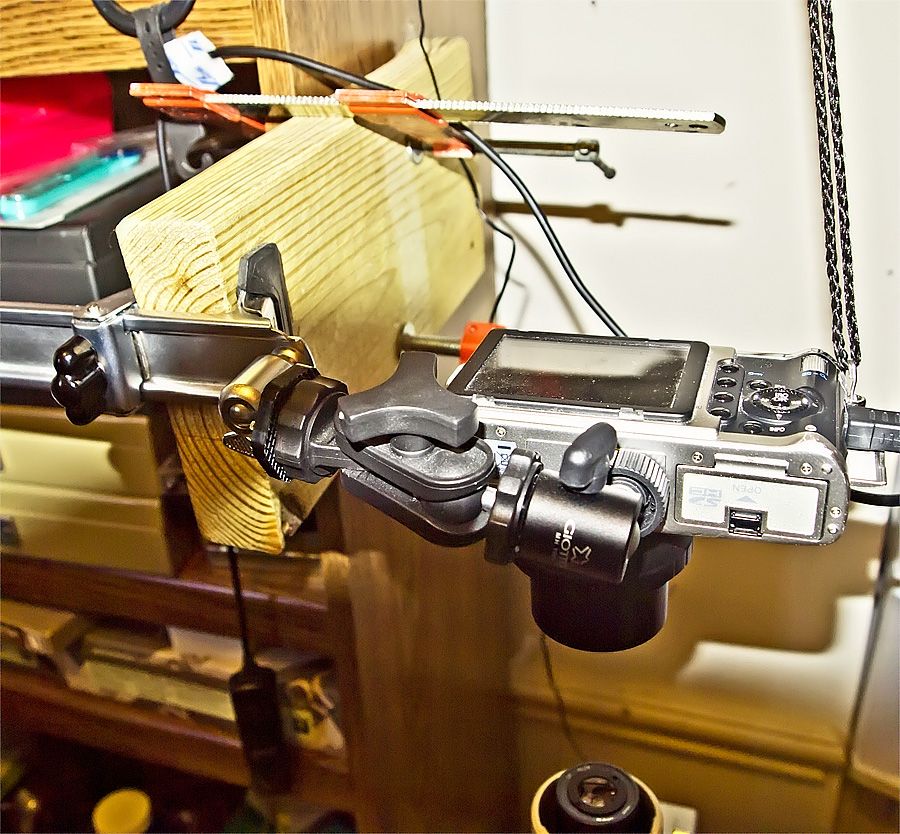
This attempts to show the way the camera is attached to the bookshelf behind and to the left of the microscope.
B. Camera with camera lens attached (this could be a DSLR or a point-&-shoot camera). This is the so-called 'afocal' method where the camera with lens "looks" through the usual microscope eyepiece (a projection lens is not used). Here the main considerations are the sizes and locations of the exit pupil of the eyepiece and entrance pupil of the camera lens needed to prevent vignetting (some zoom lenses have the entrance pupil deep inside the lens and vignetting may be unavoidable).
Parfocality: Since microscope objectives, unlike camera lenses, are designed to work at a specific, fixed distance from the object (they have a designated "working distance", the distance between the tip of the objective and the top surface of the cover glass) it is very important that the objective be used at its designed working distance. This distance is that obtained when focusing the microscope normally by looking through the eyepiece(s). It follows that the camera (whether using method A or B above) must "see" the object under the objective to be in focus when the microscope is focused using the eyepieces. It will not do to focus using the eyepieces, then refocus to get the camera image sharply focused as this will result in increased spherical aberration since the objective is not being used at its designed working distance. A very small amount of refocusing using the fine focus control (a few micrometers) if necessary may be acceptable. In setting up the camera, it is best to test for parfocality between eyepiece and camera using the lowest power objective (because this will have the smallest depth of focus).
Physical arrangement of camera to microscope. One important consideration is vibration transmitted to the microscope from the shutter and mirror of the DSLR. Some cameras have a "silent mode" or electronic shutter to eliminate shutter vibrations. If vibration is a problem, eliminating a direct physical connection between camera and microscope should solve the problem (I had to do that in my setup as I tried to show above).
Tethered operation. A camera with live-view that allows "tethered" operation, such that the image can be viewed directly on a computer monitor is a very distinct advantage (I think it would be good to consider both an electronic shutter and the ability to operate tethered when buying a new DSLR for use with a microscope).
Please consult the following links that contain very helpful, comprehensive, and authoritative information on the subject:
http://krebsmicro.com/photomic1/photomic1.html
http://www.krebsmicro.com/pdf/trinoc_a3.pdf
http://www.krebsmicro.com/Canon_EFSC/
http://micropix.home.comcast.net/~micro ... index.html
http://www.krebsmicro.com/microsetup2/index.html




 Oliver Kim -
Oliver Kim - 










